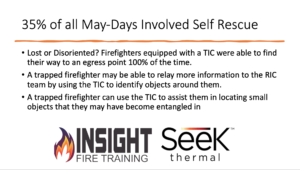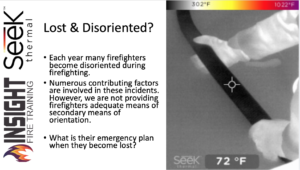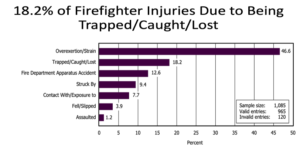Each year many firefighters become disoriented during firefighting. There are numerous contributing factors that are involved in these incidents. However, the fire service is not providing firefighters adequate means of secondary means of orientation, through training, tools, and technology. There are numerous RIT training classes, breathing equipment schools, and the training they offer has contributed to the saving of many lives. However, in those trainings a thermal imaging camera or other devices are seldom mentioned or used. The question we must ask ourselves is this:
When a firefighter becomes lost, what is their emergency plan?

Perhaps they will know how to call a Mayday, possibly extend their air supply, but what means can we provide to enable them for either self-rescue or to provide the rescuers with more information to assist in their rescue?
“The loss of direction due to the lack of vision in a structure fire — is one of the oldest, least understood and deadliest hazards of interior firefighting. However, with training, it can be prevented.” William Mora
The “U.S. Firefighter Disorientation Study 1979-2001” defines firefighter disorientation as “the loss of direction due to the lack of vision in a structure fire.”
In fact, according to the report: “Analysis of Structural Firefighter Fatality Database 2007”, over a 16-year time span, 1990-2006, enclosed structures, which have an insufficient number of windows and doors, were found to take the lives of firefighters at a disproportionate rate of 77 percent when compared to structures with an opened design.
Opened structures are those having adequate numbers of windows and doors for ventilation and emergency evacuation. This distinction in the architectural design of a structure has been shown to have major ramifications in the safety of firefighters. Additionally, the rate of multiple firefighter fatality events was even more disproportionate occurring at a staggering 84 percent at enclosed structure fires where an aggressive interior attack was utilized.
There were nine major similarities involving each of the structures and fireground operations. Of the 17 national incidents studied:
- 100% occurred in an enclosed structure.
- 94% had nothing showing, light, moderate, or heavy smoke showing on arrival
- 100% utilized an aggressive interior attack
- 100% developed prolonged zero visibility conditions
- 100% experienced handline separation or tangled handlines
- 100% experienced loss of company integrity
- 100% experienced disorientation
- 88% lacked a functioning sprinkler system
- 100% involved a disorientation sequence
What is the Disorientation Sequence?
A sequence of events that caused firefighters to become disoriented occurred in each of the 17 incidents studied. In general, the sequence unfolds as follows:
A fire in an enclosed structure with smoke showing occurs. The arriving fire company immediately initiates an aggressive interior attack to search for the seat of the fire.
During the search, the seat of the fire cannot be located, and conditions deteriorate with the production of heat, smoke and prolonged zero visibility.
As companies perform an emergency evacuation due to deteriorating conditions, handline separation occurs, or tangled handlines are encountered.
Disorientation then occurs as firefighters exceed their air supply, are caught in flashovers or backdrafts, or are trapped by the collapsing floor or roof. When the firefighters are not located quickly enough, the outcome is fatalities or serious injuries. This loss of orientation can be prevented through secondary means of orientation such a situational awareness TIC and/or devices such as the norther star fire compass.

Learn about both devices here:
What is a situational awareness TIC?
https://insighttrainingllc.com/uncategorized/do-you-know-the-2-main-types-of-fire-service-tics/
Northern Star Fire Compass:
The disorientation sequence usually plays out in a structure that does not have a sprinkler system or one that is inoperable.
This is but a summary of William Mora’s work and the full study can be viewed at the following link:
http://tkolb.net/FireReports/FirefighterDisorientationStudyJuly2003.pdf
The purpose of this article is to expound upon this work and enlighten firefighters to the fact that firefighter disorientation is still a huge problem today! According to the United States Fire Administration 18.2% of all firefighter injuries are occur from being trapped, caught, or lost. The USFA also points out that as of 2017, only 70% of all US Fire Departments had one thermal imaging camera. This data doesn’t include the type or age of TIC in use but does point to a repeated issue faced by the fire service. The issue is known as limited visibility.

Firefighter Rescue Survey points out that the majority of fire victims are also found in limited to zero visibility. In a study in Chicago, firefighters were purposefully disoriented & then given a TIC. 100% of them found their way out without injury.
Fundamental firefighting skills cannot be overemphasized. However, when a well-trained firefighter becomes lost; they should have a toolbox of options they can go to in such an emergency to begin the process of regaining orientation. This is where tools and technology can aid in assisting the firefighter as a secondary means of orientation. This by no means implies that they are to over-rely on technology to stay oriented but as a means of regaining orientation.
They are designed to be for every firefighter as a means of situational awareness. They aid in locating the fire, locating a means of egress or escape, and serve as an additional means of orientation if a firefighter becomes lost.
Secondly, they are designed to complement a crew that is equipped with a Decision-Making Thermal Imager. For example, a crew of three enters a fire environment and the crew leader (equipped with the Decision-Making TIC) directs the nozzle man to flow their stream onto a superheated area.
The firefighter who is equipped with a situational awareness tool (e.g., a mask mounted TIC) can more efficiently apply their water based on their crew leader’s guidance and the situational awareness they gather from their personal TIC.
A firefighter who becomes disoriented who is equipped with a situational awareness TIC can identify the hose line (it will show up darker as in the attached image below), they can identify doors and windows, and possibly locate other members of their crew. Therefore, these situational awareness TIC’s suddenly have more value to the organization. In the firefighter disorientation study, a sequence was identified in which firefighters become lost and disoriented. In this study, it is recommended that a thermal imager be used to prevent firefighters from becoming disoriented. Also, a situational awareness TIC often frees a firefighter’s hands to do the demanding tasks of firefighting. Imagine a crew of three firefighters who all are holding a handheld decision-making TIC. This would be create task prohibitive environment.
Whereas the move towards every firefighter having a TIC should be a common theme and not a rare occurrence as it is today.
Lieutenant Parker stated “He noted the need to move toward a TIC for each firefighter and lamented that “it is sad in today’s world to see firefighters still getting lost in smoke…When considered what we primarily deal with – total darkness and heat – the TIC should be a required tool for every firefighter.” (Whitty p. 5).
London Fire Brigade instructor Paul Grimwood perhaps best sums up thermal
imaging in the fire service when he comments “in the not-too-distant future, fighting a fire without thermal imaging will be as unthinkable as firefighting without SCBA”
The problem is well defined: Firefighters operate in extended duration time periods (longer than an SCBA bottle’s air supply will provide) in limited to zero visibility environments and are prone to disorientation.
The solution is readily available: Technological devices such as thermal imaging and directional tools such as the Northern Star Fire Compass can provide secondary means of orientation when a firefighter becomes lost.
Yet, the problem remains…
When asked why a fire department hasn’t implemented such measures for firefighter safety the following answers are often given:
- Cost or lack of funding.
- Not a topic that they are currently pursuing or interested in.
- Our department provides adequate training on firefighter survival.
So the question remains:
- What are we doing as the fire service to prevent firefighter disorientation? Training, tools, equipment, etc?
- What can we do as individual firefighters to prevent firefighter disorientation?
- What can we do as company officers to prevent firefighter disorientation?
Check out the following resources to learn more:
https://www.firehouse.com/safety-health/article/10495887/the-firefighter-disorientation-challenge
Whitty (2010). Maximizing Thermal Imaging Use in Emergency Services. Retrieved from:https://esf.com.au/wp-content/uploads/2017/03/MichaelWhitty.2010.MFB_.pdf
Firefighter Disorientation Study:
http://tkolb.net/FireReports/FirefighterDisorientationStudyJuly2003.pdf
